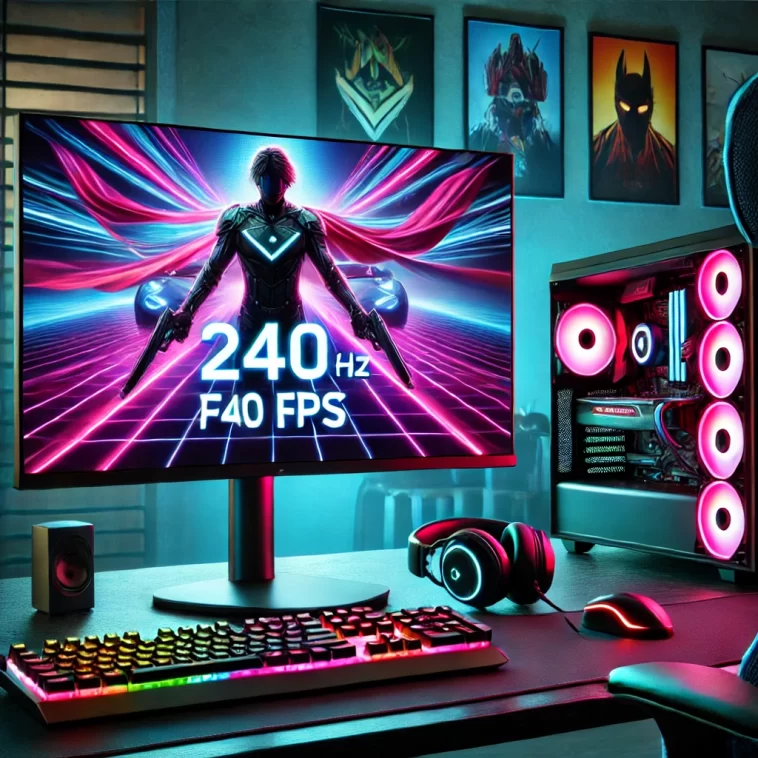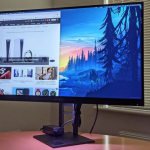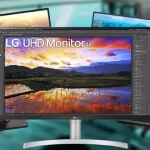Introduction
Monitors play a crucial role in the gaming experience, directly influencing how immersive and responsive gameplay can be. Among the various specifications, refresh rates and frame rates are two vital aspects that gamers often consider. This article delves into whether a 144Hz monitor can run 240 FPS, unpacking the details, implications, and best practices for optimizing your gaming setup.
Understanding Refresh Rates and Frame Rates
What is Refresh Rate? The refresh rate of a monitor, measured in hertz (Hz), indicates how many times per second the display updates with new images. A 144Hz monitor refreshes 144 times per second, making the action appear smoother compared to lower refresh rates. This capability is crucial for gamers who need fluid motion to react quickly in fast-paced games.
What is Frame Rate? Frame rate, measured in frames per second (FPS), refers to how many frames your GPU (graphics processing unit) can render per second. Higher FPS results in smoother motion and responsiveness in games. For competitive gaming, maintaining high frame rates can be the difference between victory and defeat, as it impacts how quickly and accurately you can respond to in-game events.
Why These Specifications Matter Understanding these specs is crucial for gamers, as higher refresh rates and frame rates can significantly enhance the fluidity and responsiveness of gameplay, providing a competitive edge in fast-paced games. A higher refresh rate reduces motion blur and screen tearing, while a higher frame rate ensures the game feels smooth and responsive.
Can a 144Hz Monitor Handle 240 FPS?
Technical Compatibility While a 144Hz monitor can technically display input from a system rendering at 240 FPS, it cannot fully utilize all those frames. The monitor will still only refresh 144 times per second, meaning some of the frames rendered by the GPU won’t be displayed. This results in partial utilization of the GPU’s capabilities, but the game can still feel smoother compared to running at lower FPS.
Impacts on Gaming Experience Running 240 FPS on a 144Hz monitor can still improve the overall gaming experience due to reduced input lag and more fluid motion compared to lower FPS rates. However, the full benefit of 240 FPS will not be realized unless the monitor itself supports a higher refresh rate. Players might notice a smoother experience and better responsiveness, even if every frame isn’t displayed.
Practical Considerations From a practical standpoint, a 144Hz monitor offers an excellent balance of performance and affordability. Upgrading to a 240Hz monitor may be beneficial for professional gamers or enthusiasts seeking the absolute best performance. For most gamers, however, a 144Hz monitor provides significant improvements over 60Hz or 75Hz displays without the need for an expensive upgrade.
Optimizing Performance on a 144Hz Monitor
Configuring Your System To maximize performance on a 144Hz monitor, ensure your system settings and GPU drivers are optimized. This includes setting the monitor to its maximum refresh rate in your operating system and game settings. Updating your GPU drivers can also improve performance and compatibility with the latest games.
V-Sync and G-Sync Technologies like V-Sync and G-Sync/FreeSync help manage the relationship between FPS and refresh rate, reducing screen tearing and providing a smoother experience. V-Sync synchronizes the frame rate with the monitor’s refresh rate, while G-Sync and FreeSync offer more dynamic synchronization, reducing input lag and screen tearing more effectively.
Overclocking Monitors Some 144Hz monitors can be overclocked to slightly higher refresh rates, such as 165Hz. This can offer a modest boost in performance, but it’s not a guaranteed solution and can affect monitor longevity. Overclocking should be done cautiously, as it may void the warranty and potentially damage the monitor if not done correctly.
Comparing 144Hz and 240Hz Monitors
Performance Differences A 240Hz monitor can fully utilize 240 FPS, providing the smoothest possible motion and reducing motion blur. However, the difference between 144Hz and 240Hz is less noticeable than the jump from 60Hz to 144Hz. Gamers who prioritize performance and responsiveness may appreciate the upgrade, but casual players might not notice a significant difference.
Cost-Benefit Analysis 240Hz monitors are generally more expensive. For most gamers, a 144Hz monitor offers a significant improvement over lower refresh rates and provides excellent performance without the higher cost. Investing in a 144Hz monitor is often more cost-effective, providing great performance for the majority of gamers.
Future-Proofing Your Setup Investing in a higher refresh rate monitor may future-proof your setup, ensuring compatibility with future gaming advancements and higher frame rates. As games become more demanding and hardware capabilities improve, having a monitor that can handle higher refresh rates can be a wise investment.
Common Misconceptions About Monitors and FPS
Higher FPS Always Better? While higher FPS is beneficial, diminishing returns occur beyond certain points. For most gamers, achieving stable 144 FPS on a 144Hz monitor provides an excellent experience. Beyond this point, the improvements in smoothness and responsiveness become less noticeable to the average player.
Refresh Rate vs. Resolution Balancing refresh rate and resolution is essential. High refresh rates are more beneficial for competitive gaming, while higher resolutions are favored for immersive experiences. Gamers need to consider their priorities and the types of games they play when choosing between higher refresh rates or higher resolutions.
The Role of Hardware Your CPU and GPU significantly impact your ability to reach high FPS. Ensure your hardware can support your desired performance levels. Upgrading to a powerful GPU and ensuring your CPU can handle the game’s demands are crucial steps in achieving high frame rates.
Choosing the Right Monitor for Your Needs
Gaming Preferences Consider the types of games you play. Fast-paced shooters benefit more from higher refresh rates, while slower-paced games may prioritize higher resolutions. Understanding your gaming preferences helps you make an informed decision about whether a higher refresh rate or resolution is more important.
Budget Considerations Balance your budget between a high-quality monitor and the necessary hardware to support high FPS. A 144Hz monitor is a great starting point for most gamers. Investing in both a good monitor and a capable GPU ensures you get the best possible performance within your budget.
Future Upgrades Plan for future upgrades. A 144Hz monitor can serve you well now and allow room for GPU upgrades that improve performance without needing to replace your monitor immediately. As hardware improves, having a monitor that can keep up with these advancements ensures long-term satisfaction with your gaming setup.
Setting Up Your Gaming Monitor
Choosing the Right Connection Use the appropriate connection type for your monitor and GPU. DisplayPort is generally preferred for high refresh rates and resolutions. HDMI can also support high refresh rates but may require specific versions, such as HDMI 2.0 or later.
Adjusting Monitor Settings Calibrate your monitor’s settings to optimize brightness, contrast, and color accuracy. Many monitors come with preset modes for gaming, movies, and general use. Experiment with these settings to find the best configuration for your needs.
Positioning and Ergonomics Ensure your monitor is positioned at the correct height and distance to reduce eye strain and improve comfort. Ergonomic monitor stands or mounts can help achieve the ideal setup, especially for long gaming sessions.
Graphics Settings in Games
Finding the Balance Adjust in-game graphics settings to balance performance and visual quality. Lowering settings like shadows, textures, and anti-aliasing can improve FPS without significantly impacting visual quality. Many games offer presets (low, medium, high, ultra) that can help quickly adjust settings to find the right balance.
Using Benchmark Tools Many modern games include built-in benchmarking tools that help assess your system’s performance. These tools provide valuable insights into how different settings affect FPS, allowing you to make informed adjustments.
Driver Optimization Keep your GPU drivers up to date. Manufacturers frequently release updates that improve performance and compatibility with new games. Using tools like NVIDIA GeForce Experience or AMD Radeon Software can help keep drivers updated and optimize settings for specific games.
The Importance of Smooth Gameplay
Reducing Input Lag High refresh rates and frame rates reduce input lag, making games feel more responsive. Input lag is the delay between a player’s input (e.g., a mouse click) and the corresponding action on screen. Lower input lag provides a more immediate and responsive gaming experience, essential for competitive play.
Enhancing Visual Clarity Higher refresh rates improve visual clarity, making it easier to track fast-moving objects and reducing motion blur. This can be particularly beneficial in fast-paced games where quick reactions are critical.
Improving Overall Experience A combination of high refresh rates and frame rates enhances the overall gaming experience, making games look and feel smoother and more immersive. This leads to more enjoyable gameplay, whether you’re playing competitively or casually.
Addressing Potential Issues
Screen Tearing Screen tearing occurs when the monitor’s refresh rate and the GPU’s frame rate are out of sync, causing parts of the image to misalign. Technologies like V-Sync, G-Sync, and FreeSync help mitigate this issue by synchronizing the frame rate with the monitor’s refresh rate.
Stuttering Stuttering happens when frame rates drop suddenly, causing noticeable pauses in gameplay. Ensuring stable frame rates and using adaptive sync technologies can help reduce stuttering, providing a smoother experience.
Monitor Artifacts Artifacts like ghosting and motion blur can affect visual quality. Adjusting settings like overdrive and using higher refresh rates can help minimize these issues. Overdrive settings control the monitor’s pixel response time, helping reduce ghosting.
FAQs
Can you notice the difference between 144Hz and 240Hz?
Yes, but the difference is subtle compared to the jump from 60Hz to 144Hz. Competitive gamers may notice improved responsiveness and smoother motion.
Is it worth upgrading to a 240Hz monitor?
It depends on your gaming needs and budget. For professional or highly competitive gamers, the upgrade can provide a noticeable advantage.
Can a 144Hz monitor be overclocked?
Some 144Hz monitors can be overclocked to slightly higher refresh rates, like 165Hz. Check your monitor’s specifications and warranty before attempting this.
What happens if your FPS exceeds your monitor’s refresh rate?
If your FPS exceeds your monitor’s refresh rate, you won’t see all the frames rendered, but you may still experience smoother motion and reduced input lag.
Does a higher refresh rate reduce screen tearing?
Higher refresh rates can help reduce screen tearing, especially when combined with technologies like V-Sync or G-Sync.
How do I optimize my settings for a 144Hz monitor?
Ensure your monitor is set to its maximum refresh rate in your system settings, keep your GPU drivers updated, and use technologies like G-Sync or FreeSync if available.
Conclusion
A 144Hz monitor running at 240 FPS can offer a smooth and responsive gaming experience, even if it cannot fully utilize all the frames rendered. Understanding the relationship between refresh rates and frame rates, and optimizing your setup accordingly, will help you get the most out of your gaming hardware. Whether to stick with a 144Hz monitor or upgrade to a 240Hz monitor depends on your specific needs and budget. For most gamers, a 144Hz monitor provides excellent performance and value.


